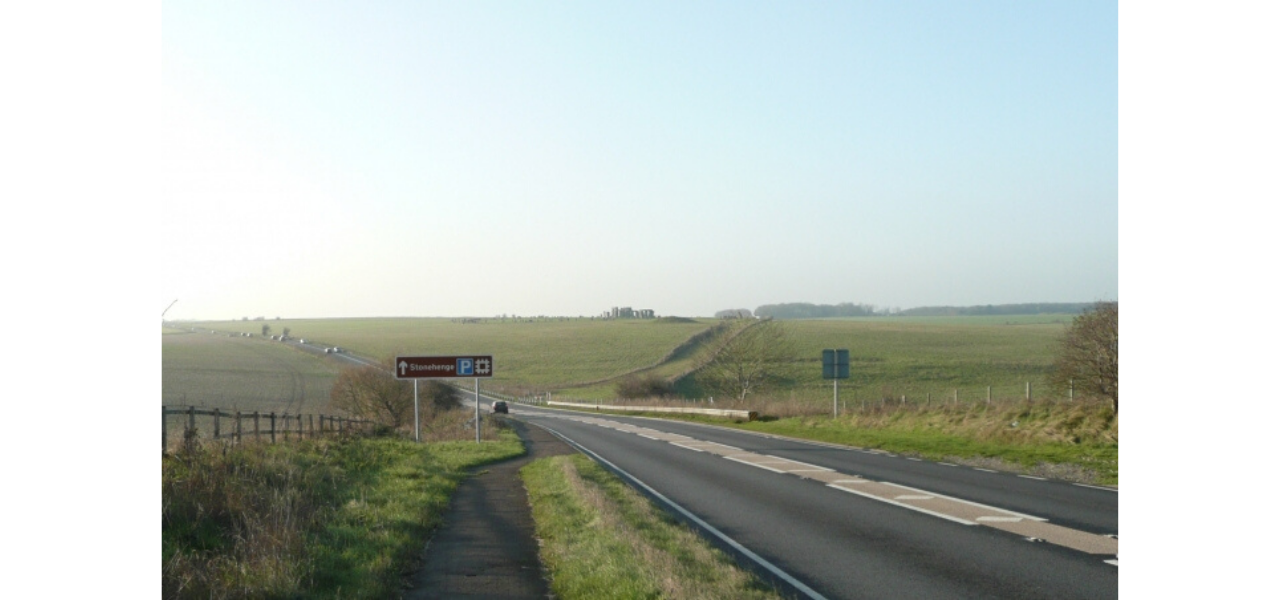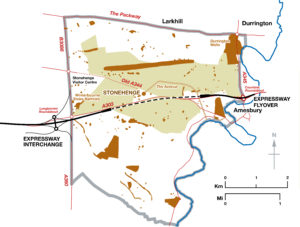Stonehenge – latest report

On Monday 19 February, 2024 we learnt that the second judicial review of the Government’s decision to approve a highly damaging, £2.5bn road scheme through Stonehenge World Heritage Site, had been unsuccessful. Mr Justice Holgate in handing down his judgement dismissed the application. Save Stonehenge World Heritage Site (SSWHS) have said that they intend to appeal the decision. The judgement comes after a 3 day hearing in the High Court in December. UNESCO, five planning inspectors and over 236,000 people were all opposed to National Highways’ highly damaging plans. Save Stonehenge WHS’s legal action had been the only thing stopping the giant earthmovers from entering this 5,000-year-old landscape. Read more on their website here
The WHS is designated by UNESCO as of “outstanding universal value” to mankind for its remarkable remains of the Neolithic and Bronze Ages. The Stonehenge Alliance, of which CPRE Wiltshire is a member, has campaigned against the road scheme for many years and is appalled by the Government’s decision in the face of strong advice from its Planning Inspectorate not to proceed. UNESCO’s World Heritage Committee has also condemned the scheme in its present form and has threatened placing Stonehenge on the World Heritage in Danger List, should it be allowed.
Stonehenge Alliance President Tom Holland says:
“Today, a supposedly Conservative government plans to blow upwards of £2 billion, at a time when the country’s finances are in a shocking state, on a monstrous white elephant of a road development that will permanently disfigure Britain’s most significant and sacred prehistoric landscape. The decision of Mark Harper to greenlight the building of a tunnel through a stretch of the World Heritage Site that surrounds Stonehenge is as inexplicable as it is disgraceful. Certainly, no-one can be in any doubt that the scheme will inflict “permanent, irreversible harm” on a landscape that is the supreme icon of British archaeology.”
The Expressway and tunnel scheme
The A303 Amesbury to Berwick Down Expressway Scheme would cross the famous Stonehenge World Heritage Site (WHS), designated for its outstanding complex of prehistoric monuments and sites. It would continue west, through fine chalk landscape. CPRE joined the Stonehenge Alliance of NGOs to oppose the proposals.
What is proposed and impacts on archaeology
The A303 preferred route, including a c.3km (c.1.8 miles) twin-bore tunnel, was announced in September 2017. The east tunnel entrances would sit within a Bronze Age barrow group and probable remains of a rare Early Neolithic settlement; the tunnel approach cuts through the ‘Nile Clumps’ of trees and threatens the integrity of the ancient Avenue and its enjoyment by visitors. The nearby Mesolithic site of Blick Mead would be dominated by a massive flyover, which would also impact adversely on Amesbury Abbey (Grade I Listed) and its Registered Park, as well as the Amesbury Conservation Area.

Map showing the route of the proposed Expressway and tunnel across the WHS.
The west tunnel portals would lie south of the present A303, near Normanton Gorse wood and not far from an RSPB Reserve, noted for rare stone curlews. Thence the new 4-lane highway would continue in a deep cutting and below a major A360 interchange just outside the boundary of the WHS involving two roundabouts with slip roads and a bridge over the A303 between them. The cutting within the WHS would pass close beside the enigmatic ‘Wilsford Shaft’, apparently used for ritual purposes or as a well (or both) throughout the Bronze Age, and possibly also during the Neolithic. Evaluation work in advance of the expressway has uncovered a Late Neolithic inhumation burial in this area and evidence of a settlement of the same date. This part of the WHS is also significant for its unique grouping of Neolithic long barrows located around the head of a dry valley, including the upstanding monument after which Longbarrow Roundabout is named. Already crossed by the A303, the physical division of this focal area of the pre-henge use of the landscape would be made far greater with a c.250 ft wide and 20 ft deep highway-cutting between the northernmost of these long barrows, interrupting the integrity of their placement and original purpose.
The scheme would impact adversely on the setting of the WHS and key archaeological sites within it; and could destroy as yet unidentified archaeological remains. The new, dualled A303 would continue, with a bridge over the River Till, as a northern bypass for Winterbourne Stoke, re-joining the present A303 via the southern boundary of Parsonage Down National Nature Reserve.
There would be local inconvenience and congestion during the c.5 years of construction and afterwards at times of tunnel closure.
Hydrogeology
Work undertaken to date has revealed more information about the presence of fractured and fissured phosphatic ‘soft’ chalk, and a fluctuating water table which can reach the surface at times. These factors give rise to serious concerns about tunnel construction impacts with possible alterations to groundwater flow and potential damage to archaeology owing to vibrations and settlement arising from tunnel boring.
Aspirations and economics
There are doubts about the aspirations for and value-for-money of the scheme.
Local people hope to be rid of traffic congestion and concomitant rat-running at busy times. Any improvement to traffic flow would, however, be temporary since it is acknowledged that road widening induces more traffic. See, e.g., a 2017 CPRE publication on the subject (reference below), which also demonstrates that widened roads rarely bring hoped-for economic benefits and increased housing to a region away from the road corridor.
The capital cost of the scheme was set by HMG in September 2017 at an upper limit of £1.6bn and is now estimated to be £1.9bn. (Estimated cost was £1.3bn in December 2014). Annual tunnel maintenance costs would be c.£7m. Public financing of the scheme has now been ruled out by the Chancellor. Economic assessment conclusions in Highways England’s application show the scheme to be low value for money with the inclusion of dubious heritage ‘benefits’ of the tunnel; otherwise it would be poor value for money.
International concern
It is of particular concern that UNESCO’s World Heritage Committee condemned the road scheme in 2019. In July 2017 and again in July 2018, the Committee advised the Government to explore options for the A303 that would not damage the WHS or its outstanding universal value. In 2021, the World Heritage Committee warned that if the scheme were not fundamentally amended, the WHS could be placed on the List of World Heritage in Danger. In view of the Government’s continuing disregard of UNESCO’s advice, we may see Stonehenge lose its designation unless the scheme is halted and/or substantially revised.
Formal examination of the road Scheme
The Infrastructure Planning Inspectorate’s website gives details of the public examination which took place in 2019. The Examination, by a panel of planning Inspectors (the Examining Authority) was mainly in writing with some issue-specific hearings in Salisbury which the public were able to attend. The Transport Secretary’s Decision Letter and Examining Authority’s Report can be seen on the Infrastructure Planning website which includes a document library.
The Stonehenge Alliance, supported by CPRE, submitted numerous Written Representations to the Examination on topics including planning considerations, biodiversity, transport and economics, tranquillity, hydrogeology, and the historic environment. These have been placed on the Inspectorate’s website here (click on documents and type “Stonehenge Alliance” in the “Filter” box). All Examination documents, including representations from other groups and individuals can be seen in the “Documents” location. Probably of most interest at this stage is our “Summary of Case” which can be read here. In addition to our written representations, the Alliance was represented and spoke to its written evidence at most of the issue-specific hearings.
Delayed decision on the Scheme
The Examination ended in October 2019. Further consultations were undertaken, in part owing to a major new find of huge pits partially encircling Durrington Walls henge in the NE corner of the WHS.
The Secretary of State’s decision to proceed with the road scheme was announced on 12 November 2020. At the same time the Examining Authority’s report was published. The Inspectors recommended, on landscape and heritage grounds, that the scheme should not go ahead. They concluded that:
“The effect of the Proposed Development on the OUV [Outstanding Universal Value] of the WHS would lead to substantial harm to the significance of the designated heritage asset. In addition, there would be considerable harm to landscape character and visual amenity. Those adverse impacts would also result in conflict with the NPPF, the Wiltshire Core Strategy and the WHS Management Plan.” and that
“. . . permanent irreversible harm, critical to the OUV would also occur, affecting not only our own, but future generations. . . . The overall effect on the WHS OUV would be significantly adverse.”
A High Court Challenge
The Transport Secretary’s Decision was challenged in a Judicial Review in 2021. The case was brought by Save Stonehenge WHS Ltd., a company set up for the purpose by individual supporters of the Stonehenge Alliance. £80,000 to cover the costs of the case was raised in donations from more than 3,000 individuals. The judgment went against the Transport Secretary’s decision on the grounds that he had not taken the impacts of the scheme on all heritage assets into account, nor undertaken mandatory assessment of alternatives.
Redetermination of the Scheme
In November 2021 it was announced that the road scheme would be redetermined. Further consultations on various matters have taken place prior to redetermination, responses to which were published on the Infrastructure Planning Inspectorate’s website in April 2022. The Stonehenge Alliance’s several responses can be seen here. We drew attention to the urgent need to address climate change which should involve reduction in road building and carbon-emitting vehicles and the provision of integrated and efficient public transport over the next few years if carbon reduction targets are to be met.
For latest information on A303 Stonehenge, please view the Stonehenge Alliance website and social media here.
Further information: documents and videos
Highways England has produced a booklet on the A303 Stonehenge scheme.
Up to date information on the A303 scheme can be followed on the Stonehenge Alliance website, where a briefing covers the issues mentioned above and more.
A video, introduced by historian Tom Holland, shows leading British Prehistoric archaeologist Professor Mike Parker Pearson explaining why the road scheme would damage the WHS.
The 300+ scheme documents can be accessed on the Inspectorate’s website here.
The Stonehenge Alliance’s responses to consultations are here.
CPRE publication, “The End of the Road? Challenging the Road Building Consensus” can be read here.
Links to older News items on this website:
An open letter from The Stonehenge Alliance, Sep 2021
Stonehenge: A brief look at the implications of the High Court judgement. August 2021.
Victory: Controversial Stonehenge road tunnel ruled unlawful. July 2021.
Legal action launched on Stonehenge road tunnel – further update. February 2021.
The Stonehenge Road Tunnel. November 2020.



